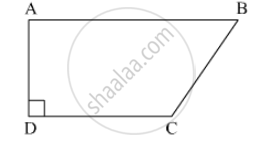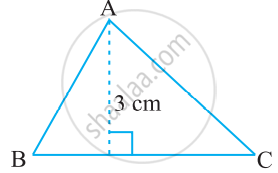Advertisements
Advertisements
Question
Find the area of a triangle with vertices at the point given in the following:
(−2, −3), (3, 2), (−1, −8)
Solution
Area of the triangle passing through the vertices `(x_1,y_1),(x_2,y_2),(x_3,y_3)`,
`Delta = 1/2 abs ((x_1,y_1,1),(x_2,y_2,1),(x_3,y_3,1))`
`Delta = 1/2 abs ((-2,-3,1),(3,2,1),(-1,-8,1))`
`= 1/2 [-2 ( 2 + 8) + 3 (3 + 1) + (-24 + 2)]`
`= 1/2 [-2 (10) + 3 (4) + (- 22)]`
`= 1/2 [-20 + 12 - 22]`
`= - 30/2`
= - 15
∴ Area = 15 square units. (As area > 0)
APPEARS IN
RELATED QUESTIONS
Find the values of k so that the area of the triangle with vertices (k + 1, 1), (4, -3) and (7, -k) is 6 sq. units.
A(4, - 6), B(3,- 2) and C(5, 2) are the vertices of a 8 ABC and AD is its median. Prove that the median AD divides Δ ABC into two triangles of equal areas.
If the points A(−1, −4), B(b, c) and C(5, −1) are collinear and 2b + c = 4, find the values of b and c.
For what value of k are the points (k, 2 – 2k), (–k + 1, 2k) and (–4 – k, 6 – 2k) are collinear ?
The coordinates of A, B, C are (6, 3), (–3, 5) and (4, – 2) respectively and P is any point (x, y). Show that the ratio of the areas of triangle PBC and ABC is
In each of the following find the value of 'k', for which the points are collinear.
(8, 1), (k, -4), (2, -5)
Find a relation between x and y if the points (x, y), (1, 2) and (7, 0) are collinear.
Find the area of a triangle with vertices at the point given in the following:
(1, 0), (6, 0), (4, 3)
Find the area of a triangle with vertices at the point given in the following:
(2, 7), (1, 1), (10, 8)
Find equation of line joining (1, 2) and (3, 6) using the determinant.
Find the area of a triangle whose vertices are
(6,3), (-3,5) and (4,2)
Find the area of a triangle whose vertices are
(a, c + a), (a, c) and (−a, c − a)
Prove that the points (2a, 4a), (2a, 6a) and `(2a + sqrt3a, 5a)` are the vertices of an equilateral triangle.
Prove that the points (a, b), (a1, b1) and (a −a1, b −b1) are collinear if ab1 = a1b.
Find the centroid of the triangle whosw vertices is (1,4), (-1,1) and (3,2) .
Show that the points are the vertices of an isosceles right triangle.
Prove that the points A(2, 4), b(2, 6) and (2 +`sqrt(3)` ,5) are the vertices of an equilateral triangle
Show that the points (-3, -3),(3,3) and C (-3 `sqrt(3) , 3 sqrt(3))` are the vertices of an equilateral triangle.
Find the area of Δ ABC whose vertices are:
A (1,2) B (-2,3) and C (-3,-4)
Show that the following points are collinear:
A(5,1), B(1, -1) and C(11, 4)
If the points P(-3, 9), Q(a, b) and R(4, -5) are collinear and a+b=1, find the value of a and b.
If the centroid of ΔABC having vertices A (a,b) , B (b,c) and C (c,a) is the origin, then find the value of (a+b+c).
In ☐ABCD, l(AB) = 13 cm, l(DC) = 9 cm, l(AD) = 8 cm, find the area of ☐ABCD.

Find BC, if the area of the triangle ABC is 36 cm2 and the height AD is 3 cm.

If the sides of a triangle are 3 cm, 4 cm and 5 cm, then the area is
The table given below contains some measures of the right angled triangle. Find the unknown values.
| Base | Height | Area |
| 5 feet | ? | 20 sq.feet |
If A, B, C are the angles of a triangle, then ∆ = `|(sin^2"A", cot"A", 1),(sin^2"B", cot"B", 1),(sin^2"C", cot"C", 1)|` = ______.
If the points (3, -2), (x, 2), (8, 8) are collinear, then find the value of x.
Find the area of the triangle whose vertices are (-2, 6), (3, -6), and (1, 5).
The area of a triangle with vertices A(3, 0), B(7, 0) and C(8, 4) is ______.
Find the value of m if the points (5, 1), (–2, –3) and (8, 2m) are collinear.
The base and the corresponding altitude of a parallelogram are 10 cm and 3.5 cm, respectively. The area of the parallelogram is 30 cm2.
Find the cost of laying grass in a triangular field of sides 50 m, 65 m and 65 m at the rate of Rs 7 per m2.
The area of a trapezium is 475 cm2 and the height is 19 cm. Find the lengths of its two parallel sides if one side is 4 cm greater than the other.
Find the missing value:
| Base | Height | Area of parallelogram |
| ______ | 8.4 cm | 48.72 cm2 |
Area of a triangle = `1/2` base × ______.
Triangles having the same base have equal area.
